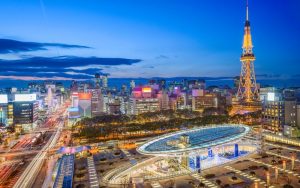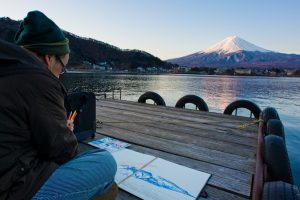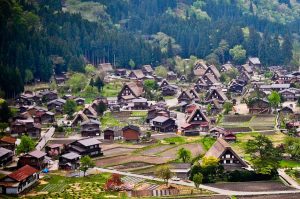The Chūbu region, also known as the Central region, encompasses a large area in the middle of Japan’s main island of Honshū. The region is aptly named (Chūbu literally means “middle part” in Japanese) and contains several major Japanese cities including Nagoya and Nagano.
Divided by the rugged mountains of the Japanese Alps, the region experiences two dramatic climates in winter; sunny and mild on the side of the Pacific Ocean, and cold and snowy on the side of the Sea of Japan coast.
This extensive guide to the region helps travelers to plan what they should include on an itinerary for Chūbu, from a stay in some of Japan’s best winter sports resorts to a day trip to the iconic Mount Fuji. It will also help you understand which train lines you can use in the region using your JR Pass.
Chubu prefectures
Chubu is usually divided into 3 separate subregions: Tōkai, Kōshin’etsu, and Hokuriku. Some business circles also add another subregion, Chūkyō.
These subregions are further divided into 9 prefectures:
- Aichi – This prefecture on Japan’s Pacific Ocean coast forms part of the Tōkai region and is home to Nagoya, Japan’s third-largest city.
- Fukui – Located on the coast of the Sea of Japan, Fukui Prefecture is part of the Hokuriku region. Major cities include the capital, also named Fukui, as well as Sakai, Echizen, and Sabae.
- Gifu – Situated in the center of Japan, Gifu is one of only 8 eight landlocked prefectures in the country. Historically, it served as a major crossroads for routes connecting the east and west of Japan. Home to the capital, Gifu City.
- Ishikawa – This prefecture on the Sea of Japan coast is located around Toyama Bay, one of the largest bays in Japan. Contains the capital, Kanazawa, and other major cities include Hakusan, Komatsu, and Kaga.
- Nagano – Another landlocked prefecture, Nagano encompasses a large area of the Japanese Alps, and induces areas belonging to the Hida Mountains, Kiso Mountains, and Akaishi Mountains. The capital city, Nagano, is a popular destination for winter sports enthusiasts in Japan.
- Niigata – Home to Niigata City, the largest metropolitan area on the Sea of Japan coast. The prefecture also includes Sado Island, the sixth-largest island in Japan.
- Shizuoka – Contains the capital city of Shizuoka, Suruga Bay, and Lake Hamana, one of the largest lakes in Japan. The iconic Mount Fuji is partially located in this prefecture, on the border with Yamanashi.
- Toyama – Major cities in Toyama include the capital of the same name, as well as Takaoka, Imizu, and Nanto. Roughly 30% of the prefecture is designated as Japanese national parks and it is also home to the only known glaciers in East Asia outside of Russia.
- Yamanashi – Another prefecture with a large area designated to national parks, the majority of Yamanashi’s population lives in the central Kōfu Basin, which is home to the capital city of the same name and surrounded by the Akaishi Mountains.
Top destinations in Chubu
The region of Chūbu covers much of central Honshu, and, as a result, contains some of the most notable prefectures and cities on the island.
Some of the most popular destinations in Chūbu include:
Kanazawa
Kanazawa is known as ‘Little Kyoto’, though it is a unique destination in its own right. The capital of Ishikawa Prefecture, it offers a huge number of historical attractions, Buddhist temples, and interesting museums, as well as fascinating samurai and geisha districts.
Kanazawa’s best-known attraction is the 17th-century Kenrokuen Castle. This impressive piece of historic architecture boasts one of the country’s very best landscape gardens and it draws visitors from both across Japan and abroad.
Nagano
Nagano is a prefecture full of breath-taking mountain scenery and rich history. Its capital, Nagano City, originated as a humble “temple town,” centered on the popular Zenkoji temple.
The rugged forests north of Nagano City still resonate with the legends and realities of the ninja, skilled warriors of the past. In modern times, Nagano again invited “warriors” of great skill when it hosted the 1998 Winter Olympics. In fact, the Hokuriku Shinkansen opened in October 1997, just in time for the games.
Nagoya
Nagoya is Japan’s fourth most populous city. Easy to access on a day trip from either Tokyo, Kyoto, or Osaka, the capital of the prefecture of the same name has something to offer everyone, from ample shopping opportunities to kid-friendly amusement parks.
Nagoya originated as a castle town known as Owari during the Edo Period (1603 to 1867 C.E.) However, much of its historic architecture was destroyed during the bombing raids of World War II. Today, it is a city of boundless technology, including the Toyota Motor Corporation headquarters just outside the city limits.
Niigata
Niigata Prefecture is well known for its quality rice, summer fireworks, winter skiing, and year-round onsen. The prefecture’s capital, Niigata City, represents the largest port on the Chubu Region’s Japan Sea coast and is home to more than 800 thousand people.
One of Niigata’s most famous landmarks is the six arches of the Bandai Bridge. The bridge was completed in 1929, is illuminated at night, and supports 20,000 dancers during the annual daiminyonagashi, or Folk Dancing Parade. However, the bridge represents just one of the many appealing attractions that Niigata has to offer.
Takayama
When many international travelers think of Japan, they call to mind visions of crowded “neon cities” such as Tokyo. Japan, however, has a much gentler side, complete with rolling hills and rustic charm. The town of Takayama and the Japanese Alps mountain range in the Hokuriku region represent one such rural destination.
Best things to do in Chubu
The major attractions for visitors to the Chūbu region include natural wonders such as high mountains and deep gorges, as well as historic monuments, and modern theme parks.
Some of the must-visit attractions in Chūbu include:
Mount Fuji
A day-trip from Tokyo to Mount Fuji and the lesser-known Hakone five lakes area is among the favorite experiences of many travelers to Japan, so here is our guide on how to visit this famous landmark with the Japan Rail Pass. Whether you prefer climbing or a more relaxed pace, we have the perfect guide for you make the most out of this trip!
Chureito Pagoda
What is a pagoda? It is a towerlike, tiered structure traditionally associated with Buddhist temple complexes. Pagodas are common sights throughout eastern and southeast Asia, including Japan. Pagodas are meant to symbolize sacred mountains and often shelter religious relics.
The Chureito Pagoda, also called the Chastain Tower and officially named the Fujiyoshida Cenotaph Monument, is a shrine located in the Fuji Five Lakes region at Mount Fuji’s northern base. The Pagoda has five stories; it is situated on a mountainside overlooking Fuji Yoshida City, with Mount Fuji itself visible in the distance. You have probably seen pictures of a beautiful pagoda with Mount Fuji in the background, this is the Chureito Pagoda.
Kurobe Gorge
The Northern Japan Alps is a scenic volcanic mountain range spanning parts of Toyama, Nagano, and Gifu Prefectures. This range is home to the Kurobe River and one of the deepest and most beautiful forested ravines in the country.
The Kurobe Gorge is a famous destination for enjoying natural beauty. Visitors flock to this site to view stunning autumn colors and relax in natural hot springs. The Gorge makes an ideal day trip for hiking or viewing autumn leaves.
Shirakawa-go
Picture a quaint village embanked in snow. Icy whiteness covers the ground and clings to the roofs of the traditional Japanese farmhouses like icing on a gingerbread house. Streets and windows become golden torches as the sun begins to set.
The Historic Villages of Shirakawago and its neighboring village, Gokayama are one of central Japan's UNESCO World Heritage Sites. They hold a serene natural beauty as well as a unique architecture.
Ghible Theme Park (coming soon)
Children around the world have grown up with beloved animated films from Hayao Miyazaki and Studio Ghibli. Since 1984, Studio Ghibli films have often served as an introduction to the wider world of anime and have obtained a cult following all their own.
Many Ghibli fans have already made a pilgrimage to the popular Studio Ghibli museum in Tokyo. Others eagerly anticipate the release of the upcoming Ghibli film, How do you Live? But fans will be thrilled to learn that the Ghibli theme park opened on November 1, 2022, and is now bringing the films to life in Nagoya!
Main train lines and transportation
Some of the train and Shinkansen lines in the Chūbu region ou can expect to use while in the area include:
- Tokaido Shinkansen
- Joetsu Shinkansen
- Hokuriku Shinkansen
- Tokaido Main Line
- Wide View Hida Limited Express
Other regions of Japan
Although Okinawa is sometimes regarded as a 9th region, Japan is traditionally considered to contain 8 regions. These are as follows:










